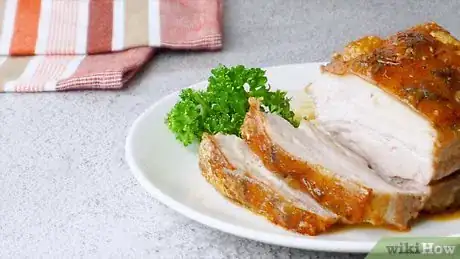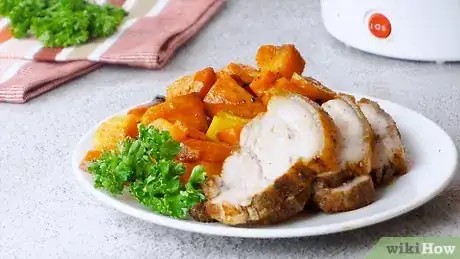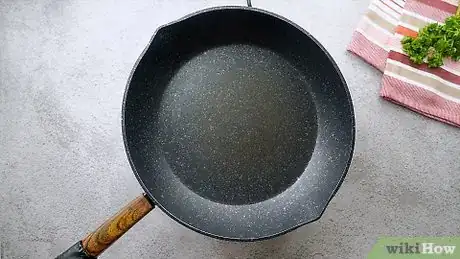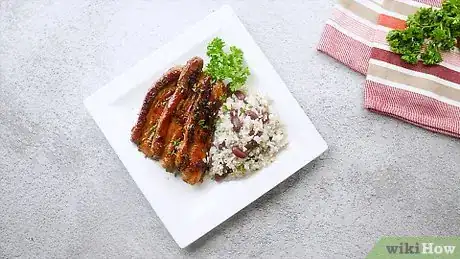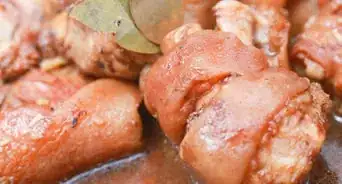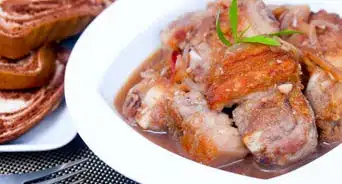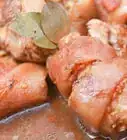wikiHow is a “wiki,” similar to Wikipedia, which means that many of our articles are co-written by multiple authors. To create this article, 11 people, some anonymous, worked to edit and improve it over time.
The wikiHow Culinary Team also followed the article's instructions and verified that they work.
This article has been viewed 315,457 times.
Learn more...
Pork belly is a fatty and flavorful cut of meat used to make bacon, but can be prepared in a variety of ways. Whether you want to cook it in the oven, slow cooker, or pan fry it on the stove, pork belly can be a delicious addition to your meal.
Ingredients
Makes 6 to 8 servings
- 2 lb (900 g) pork belly
- 1/3 cup (80 ml) olive oil
- 1 Tbsp (15 ml) sea salt
- 1 Tbsp (15 ml) ground black pepper
Makes 6 to 8 servings
- 2 lb (900 g) pork belly
- 2 tsp (10 ml) sea salt
- 2 tsp (10 ml) ground black pepper
- 2 tsp (10 ml) chili powder
- 2 Tbsp (30 ml) olive oil
- 1/4 cup (60 ml) apple cider vinegar
- 1 cup (250 ml) carrots, chopped into 2-inch (5-cm) pieces
- 1 cup (250 ml) sweet potatoes, cut into 2-inch (5 cm) pieces
Makes 3 to 5 servings
- 1 lb (450 g) pork belly
- 2 Tbsp (30 ml) honey
- 2 Tbsp (30 ml) soy sauce
- 1 Tbsp (15 ml) oyster sauce
- 1 tsp (5 ml) fresh minced garlic
Steps
Oven Roasting
-
1Preheat the oven to 425 degrees Fahrenheit (220 degrees Celsius). Meanwhile, prepare a baking dish by inserting an elevated cooking rack.
- If you don't have an elevated rack, crumple up several sheets of aluminum foil and scatter them across the bottom of the baking dish.
- You'll need to keep the pork belly elevated as it cooks to help the fat render more readily.
-
2Score the meat. Using a sharp knife, the skin of the pork belly in a cross-hatch pattern. Slice across the skin in vertical rows spaced 2 inches (5 cm) apart, then create a series of perpendicular slices that are also spaced 2 inches (5 cm) apart.
- Pierce through the tough skin and the top layer of fat, but do not cut too deeply into the actual meat lying beneath the two.
- Scoring the meat in this manner will allow more of the fat to render out during the roasting process.
Advertisement -
3Rub in the oil, salt, and pepper. Place the pork belly on your prepared baking rack with the skin-side facing up. Rub the top with oil, then generously season the meat with salt and pepper.
- In addition to seasoning the meat, the oil and salt make it easier for the fat to render out, resulting in crispier skin.
- Apply the seasonings by hand, and work the salt and pepper into the slits across the skin.
- Note that salt and pepper should withstand the roasting process without deteriorating, but other spices and herbs might burn. If you decide to add others, do so within the final 30 minutes of cooking.
-
4Cook for 20 to 30 minutes. Place the seasoned pork belly in the preheated oven. Roast it for 20 to 30 minutes, or until the skin browns and begins to look crispy.
- This brief period of high heat will not cook the pork through, nor should you cook the pork belly at this high heat for the entire time. The intense heat is only meant to crisp the skin.
- Do not wait for the skin to become dark brown or fully crisped since it will continue cooking at a lower temperature. Cooking it for too much time at a high heat could cause it to burn before the rest of the meat finishes.
-
5Decrease the heat to 350 degrees Fahrenheit (180 degrees Celsius). Decrease the temperature without removing the pork belly. Allow the meat to cook for another 2 to 2-1/2 hours, or until done.[1]
- Check the pork belly halfway through the cooking process. If the fat gets too hot, it may start to smoke, and you'll need to transfer the meat to a clean baking dish.
- The pork belly must reach a minimum internal temperature of 160 degrees Fahrenheit (70 degrees Celsius) before you remove it from the oven.
-
6Let it rest for 10 to 15 minutes. After removing the pork belly from the oven, allow it to rest for 10 to 15 minutes before carving it.
- During this time, the juices should distribute themselves and settle within the meat.
-
7Serve while still hot. Roasted pork belly will have crispy skin, but the inner meat should be tender and moist.
- Store any leftovers in an airtight container in your refrigerator.
- When reheating the leftovers, sear the slices in a skillet so that the skin remains crispy.
Slow Cooking
-
1Season the pork belly overnight. Rub all sides of the pork belly with the salt, pepper, and chili powder. Wrap the meat in plastic wrap, then let it sit in your refrigerator overnight.[2]
- Mix the spices together in a small dish before rubbing them over the surface of the pork belly. Doing so will ensure an even distribution of each spice.
- If you're short on time, you don't have to let the pork sit overnight. Doing so can help tenderize the meat and improve the flavor, but it will still cook just fine if you season the meat and immediately proceed to the next step.
-
2Score the skin. Using a sharp knife, cut parallel diagonal lines across the skin-side of the pork belly. Cut a series of perpendicular diagonal lines over the first set, creating a cross-hatch pattern.
- Scoring the skin will help the fat render as the meat cooks. Try to cut through both the skin and top layer of fat, but don't cut too deeply into the meat beneath these top two layers.
-
3Heat the olive oil in a skillet. Pour the olive oil into a large skillet and set the pan over medium-high heat.
- Wait roughly 60 seconds for the oil the become adequately hot. Carefully turn the pan so that the hot oil coats the entire bottom.
-
4Sear all sides of the meat. Place the pork belly in the hot oil. Sear each side for 60 seconds, or until it looks light brown and crispy.
- You need to sear the thin sides of the pork belly, too. This may require you to hold the pork belly in place with tongs.
- The pork belly won't crisp up much in the slow cooker, which is why you should brown the skin on the stove before cooking the rest of the meat.
-
5Place the ingredients in the slow cooker. Spread the carrots and sweet potatoes over the bottom of the slow cooker. Place the pork belly on top, then pour the apple cider vinegar over everything else.
- If desired, you can use other root vegetables instead of sweet potatoes and carrots. Brussels sprouts, potatoes, and turnips are other popular options.
-
6Cook on high for 4 to 5 hours. Cover the slow cooker and switch it onto its high heat setting. Allow the pork belly to cook until done—roughly 4 to 5 hours.
- When ready, the pork belly should reach a minimum internal temperature of 160 degrees Fahrenheit (70 degrees Celsius).
-
7Serve hot. Switch off the heat and allow the pork belly to rest for 10 minutes before carving it. The meat should be very tender and moist when you do cut into it.
- Store leftovers in an airtight container kept in the refrigerator. You can reheat the leftover slices in a skillet so that the skin stays crispy.
Pan Frying
-
1Heat the dry skillet. Set a large skillet on the stove over medium-high heat. Do not add any oil to the skillet.
- Since pork belly contains so much fat, adding extra oil isn't necessary. You can do so to speed up the browning process, but be aware of the fact that the addition of extra oil increases the likelihood of oil splatters.
-
2Cut the pork belly into slices. Using a sharp knife, cut the pork belly into 1/4 to 1/2 inch (6 to 12 mm) thick slices.
- You do not need to score the skin when pan frying pork belly. Cutting the meat into slices exposes enough of the fat, so it should render well enough even in spite of the thick skin layer.
-
3Brown the pork belly. Place the slices of pork belly in the hot pan and cooking, turning often, until both sides of each slice are golden-brown and crispy.
- The exact amount of time can vary depending on how crowded the pan is, but 4 to 5 minutes per side will usually be enough time.
- Use tongs to carefully turn and rotate the slices. If the oil begins to splatter, use a splatter screen to minimize the mess.
-
4Add the seasonings. Once the pork belly is well-browned, drain the excess fat and add the honey, soy sauce, and oyster sauce, and garlic.
- If puddles of fat remain on the slices of pork belly even after you drain the pan, you may need to dab off the excess fat using clean paper towels.
- Consider mixing the seasoning ingredients together in a separate bowl before adding them to the pan. Doing so can ensure an even distribution of flavors.
-
5Reduce the heat and continue cooking. Reduce the heat to medium, then continue cooking until the sauce thickens and coats the pork belly like a glaze.
- You'll need to continue flipping and rotating the slices so that all sides are coated in the sauce.
- The exact amount of time may vary, but expect this part of the process to take roughly 2 to 3 minutes.
-
6Serve hot. Remove the pan from the heat and serve the pork belly slices with their glaze.
- You can store leftovers in an airtight container kept in the refrigerator. Reheat them on the stove to maintain the crispy texture of the meat.
Our Most Loved Articles & Quizzes
Community Q&A
-
QuestionWhat can I do with the fat that renders from a pork belly?
 MicheleTop AnswererRendered pork fat is lard, and lard can be used as a substitute for butter or oil. You've got all that scrumptious pork flavor and it's virtually kitchen gold. Just make sure you store it in a sealed container in the fridge. Some ideas for its use are in mashed potatoes, homemade pasta noodles, baste other meats with it, fry an egg, use it for sauces, in vinaigrettes or add to a warm potato salad. The possibilities are only limited by your imagination.
MicheleTop AnswererRendered pork fat is lard, and lard can be used as a substitute for butter or oil. You've got all that scrumptious pork flavor and it's virtually kitchen gold. Just make sure you store it in a sealed container in the fridge. Some ideas for its use are in mashed potatoes, homemade pasta noodles, baste other meats with it, fry an egg, use it for sauces, in vinaigrettes or add to a warm potato salad. The possibilities are only limited by your imagination. -
QuestionHow much apple cider vinegar do I use?
 MicheleTop AnswererThe ingredients list a 1/4 cup.
MicheleTop AnswererThe ingredients list a 1/4 cup.
Things You'll Need
Oven Roasting
- Baking dish
- Cooking rack or aluminum foil
- Sharp knife
- Meat thermometer
Slow Cooking
- Small bowl
- Plastic wrap
- Sharp knife
- Large skillet
- Tongs
- Slow cooker
- Meat thermometer
Pan Fried
- Large skillet
- Tongs
- Sharp knife
- Small bowl
- Paper towels
References
About This Article
If you’re cooking pork belly on the stove, cut the meat into strips that are 1/4 to 1/2 inch to thin. To cook, lay the strips on a dry skillet over medium-high heat. Don’t worry about adding additional oil, since pork belly has a high fat content. Cook the strips for 4 to 5 minutes, flip, and cook for an additional 4 to 5 minutes. Then, add seasonings, like soy sauce and minced garlic, and continue to cook it for 3 minutes. Serve the strips while they’re still hot. To learn about how to slow cook or oven roast pork belly, scroll down for the rest of the article!

